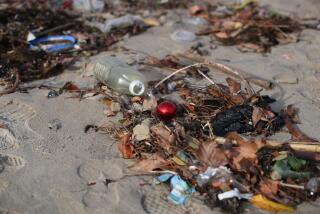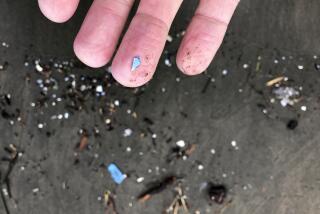A Warning for Microwave Users
Chemicals commonly found in plastic containers or wraps can seep into food when both come in direct contact during microwave heating, state health officials recently reported.
The most common of the compounds present in these food storage products are plasticizers used to enhance the material’s flexibility. This substance, and other chemicals present, can leach into food at high microwave temperatures, according to a report in California Morbidity, a state Department of Health Services newsletter.
There is no known danger from ingestion of these additives in trace amounts, however, the agency advises consumers to minimize intake of foods microwaved in some plastics.
“It is prudent to avoid unnecessary exposure to plasticizers by avoiding direct contact of plastic wraps (with) food during microwave cooking,” the report stated. “Ingestion of plasticizers in small quantities is thought to be safe although research into long-term health effects of plasticizers and additives continues.”
Most wraps and containers are intended solely for food storage and not cooking. As such the U.S. Food and Drug Administration considers the items housewares and thus does not regulate the category. However, manufacturers are increasingly using the term microwaveable on product labels, the newsletter stated.
Furthermore, consumers are frequently reheating take-out items in the plastic containers in which foods are purchased instead of warming the items in ceramic cookware.
“These products may have received prior approval as ‘food packaging’ but not under conditions of high temperature. The term ‘microwavable’ printed on many boxes of plastic wrap, does not indicate FDA approval for that use. The industry is self-regulated and conducts its own research to determine the safety of its products in microwave ovens,” reported California Morbidity.
The plastic is not heated by microwaves during cooking, for instance. Rather, problems of seepage occur when the plastic wrap or container comes in contact with hot food--a reaction that’s particularly likely with high-fat meats and dairy-based items.
Those wraps and freezer bags made of polyethylene are not among the items singled out in the advisory from the health services department. Although there is some concern that chemical leaching does occur when any ink printing--such as brand names--is present on these otherwise safe polyethylene materials.
The state has issued several recommendations for plastics in the microwave. They are:
--Don’t use visibly damaged or stained plastics.
--Avoid using the container if it has an intrinsically unpleasant odor; the scent could be absorbed into the food.
--Avoid using paper and plastic (container) products with dyes, printer’s ink or glue.
--Do not place plastic wrap in direct contact with foods being heated. Use plastic wrap only to cover food containers.
Forgetting Aesthetics--Yet another food safety issue surfaced recently when a public health newsletter discussed the problem of infestation in grains and cereals. This time, oddly enough, little fuss was made regarding the presence of certain insects in food.
“It may bug you to find beetles in your breakfast cereal, but the only harm insects that infest grain products really do is to your sensibilities. You can eat them without worry,” the UC Berkeley Wellness Letter reported.
Normally a traditionalist on sanitation practices, the newsletter, surprisingly, urged consumers confronted with insects in their grains to remain calm.
“If you find evidence of insects in a new purchase, you can always take the product back to the store for a refund. It might be easier, however, simply to sift or pick them out,” the report stated.
These types of impurities are the byproduct of modern processing methods and are often unavoidable. As such, the FDA has established allowable levels for insect fragments in such foods: 50 fragments per 50 grams (about two ounces). The publication went on to state that even at higher levels the residue is not harmful.
“Grain products in all stages of growth, processing and packaging are prey to beetles, moths, weevils and their eggs,” according to the Wellness Letter. “Infestation often occurs in the field or in warehouses, where voracious pests lurk in improperly cleaned storage bins. Insects or their residue--including eggs--probably inhabit your grains by the time they reach your shelves.”
Warm summer weather intensifies the problem and those concerned about infestation are advised not to store items such as whole wheat, cornmeal and other unprocessed whole grains for long periods of time.
“Try not to purchase grain products in amounts much larger than you’ll use in one or two months,” the article stated.
Spud Consciousness--Popular perceptions are also bugging the potato industry. In this case, the growers and shippers of tubers are complaining that too many people associate spuds with calories.
To change this troubling image, the Potato Board has tried a disingenuous tact. The trade group is running a series of advertisements depicting a russet partially painted green. The photo is accompanied by a headline which asks, “How Far Must We Go Before You Think of Us as a Vegetable?”
The ad further states, “We can’t figure it out. We’re nutritious and we’re low in calories. We’re even a plant. But still, most people don’t think of potatoes as a vegetable . . . Maybe it’s because we’re not green.”
“So, maybe if we paint ourself green you’ll start to think of us as a vegetable,” the ad initially suggests.
Promotion, of course, wins out as the ad concludes that there is “something special about potatoes.” Green or otherwise.
More to Read
Sign up for Essential California
The most important California stories and recommendations in your inbox every morning.
You may occasionally receive promotional content from the Los Angeles Times.










